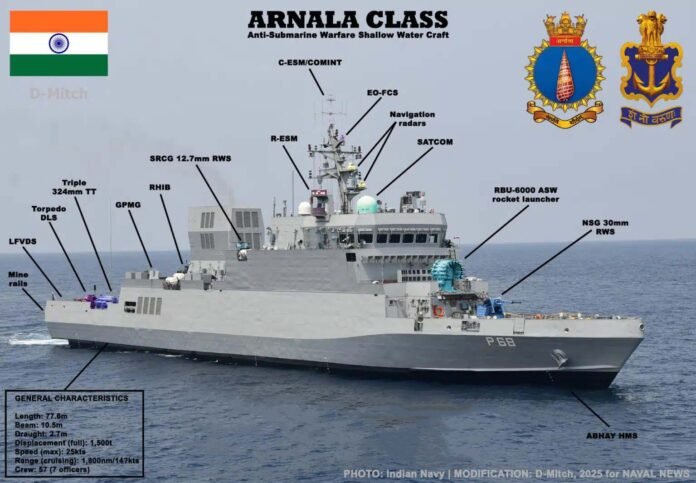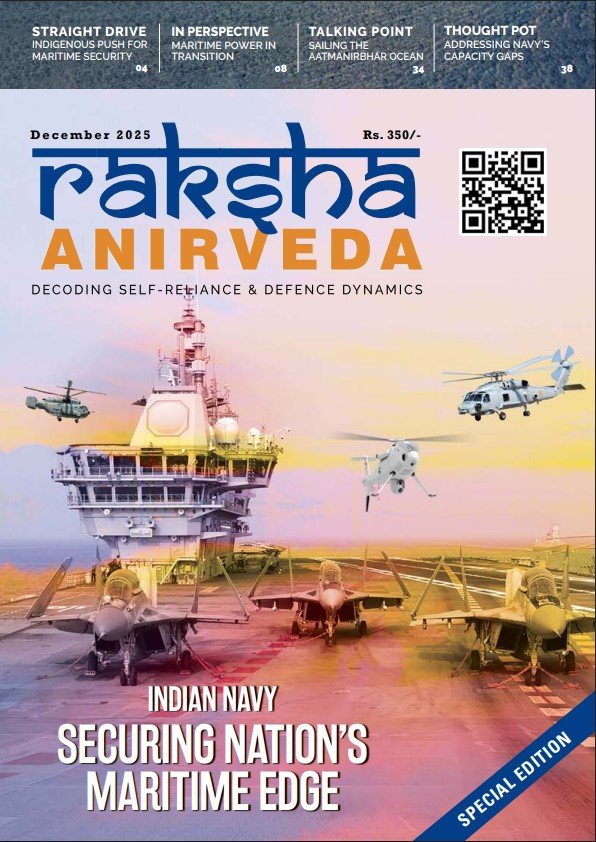The Indian Navy is currently immersed in one of the most ambitious and transformative expansion programmes in its history, a testament to India’s rising stature as a maritime power. This bold initiative, spearheaded by India’s political and defence leadership under the guidance of Prime Minister Narendra Modi and Defence Minister Rajnath Singh, is driven by a clear and unwavering vision. This vision is centred on asserting India’s dominance across the vast and strategically vital Indian Ocean Region (IOR) while simultaneously extending its influence deep into the broader Indo-Pacific theatre. The primary objective is to ensure that critical sea lines of trade—lifelines that facilitate the movement of goods, energy, and commerce for nations across the region—remain secure, open, and accessible to all, fostering stability and prosperity in this increasingly contested maritime domain.
Over the past decade, India and its Indian Navy have experienced an extraordinary blossoming, largely due to the personal interest and strategic oversight provided by Prime Minister Modi, hailing from the maritime-rich state of Gujarat, which has a deep historical connection to seafaring and trade. His understanding of the pivotal role military power plays in national security and global influence was vividly demonstrated during Operation Sindoor, a landmark military operation conducted between 7th to 10th May 2025. Air Chief Marshal A P Singh, a key figure in India’s air defence strategy, detailed how the state-of-the-art S-400 Air Defence (AA) Systems, recently integrated into India’s air defence network, showcased their formidable capabilities by downing six aircraft of the Pakistan Air Force at an impressive range of 300 kilometres. This success came after a series of precise strikes that neutralised nine terror camps located within Pakistan, achieving this with minimal loss to Indian forces. Although the Indian Navy did not directly engage its weaponry during this operation, it played a crucial supporting role by maintaining an operationally poised presence.

This included a formidable combination of air assets, submarines, and missile-equipped vessels strategically positioned off the Makran coast along Pakistan’s southwestern border, serving as a potent threat to potentially blockade Pakistan’s maritime routes. This tactical deployment is famously referred to as the ‘Strategic Naval Manoeuvre’, a calculated strategy designed to exert economic pressure by starving a nation of essential supplies through maritime isolation. The Hindustan Times, a leading national daily, reported that PM Modi personally commended Naval Chief Admiral Dinesh K Tripathi for the Navy’s readiness, reassuring him that while the Navy did not take part in Operation Sindoor, its moment to shine in future operations would undoubtedly arrive.
India did not have the luxury of choosing its geography or its neighbours, yet in this emerging 21st ‘Century of the Seas’, a term coined to highlight the growing importance of maritime power in global affairs, India finds itself in a remarkable ‘sweet spot’. This advantageous position stems from its unique geographic configuration, where the Indian subcontinent juts into the Indian Ocean like a dagger, providing natural leverage to command the vital IOR. This strategic location enables India to exert significant influence across a wide maritime expanse, stretching from the Strait of Hormuz in the Persian Gulf—a chokepoint for global oil supplies—to the Strait of Malacca in Southeast Asia, a critical artery for international trade. The Indian Navy’s modernisation efforts are a cornerstone of India’s pursuit of strategic autonomy, with an ambitious blueprint to expand its fleet to over 150 warships and 300 aircraft by 2035.

This includes the deployment of two aircraft carriers to project power across the seas, six nuclear-powered submarines to enhance underwater deterrence, and a robust anti-submarine warfare (ASW) capability to counter emerging underwater threats. This expansion reflects India’s unwavering commitment to safeguarding its expansive Exclusive Economic Zone (EEZ), which spans over 2 million square kilometres of resource-rich waters, and protecting critical maritime trade routes that handle approximately 90 of India’s trade by volume and a significant portion of its energy imports.
Indigenous content in major combatants now typically ranges from 65 per cent to 97 per cent, depending on the class and fit. This includes hull, propulsion auxiliaries, sensors, weapons integration, and combat management suites that are largely designed and built in India
The Indian Navy’s order book serves as a vivid testament to this visionary approach, showcasing a series of significant contracts awarded to Indian shipyards and indigenous industries, reinforcing the nation’s self-reliance in defence manufacturing. These contracts highlight a diverse range of vessels and platforms designed to meet both current and future operational needs. The key orders include:
- Four Survey Vessels (Large) with a displacement of 3400 tons, featuring dimensions of length 110 metres x width 18.65 metres, ordered on 20th July 2020 from Garden Reach Shipbuilders & Engineers (GRSE), a premier public-sector shipyard based in Kolkata, for a total value of ₹2,083.82 crore. These vessels are equipped with advanced hydrographic survey equipment to map the ocean floor and support navigational safety.
- Six Next Generation Corvettes with a displacement of 3200 tons, designed with dimensions of length 105 metres x width 15 metres, ordered on 18th September 2020 from Coastal Shipyard Limited (CSL), located in Kochi, for ₹5,749.87 crore. These corvettes are built for multi-role operations, including anti-submarine warfare and surface combat.

- Seven Project 17A Frigates with a displacement of 6700 tons, featuring dimensions of length 149 metres x width 17 metres, ordered on 20th January 2021 from Mazagon Dock Shipbuilders Limited (MDL), Mumbai’s leading shipyard, for ₹12,423.65 crore, with an additional three units ordered from Larsen & Toubro (L&T), a private-sector giant, for ₹19,048.37 crore. These stealth frigates are designed for advanced warfare capabilities, including missile defence and electronic warfare.
- Five Diving Support Craft with a displacement of 345 tons, featuring dimensions of length 30 metres x width 13 metres, ordered on 12th February 2021 from Titagarh Rail Systems Limited (TRSL) at Kolkata for ₹174.77 crore. These craft are essential for underwater salvage and support operations.
- Two Multi-purpose Vessels with a displacement of 3500 tons, designed with dimensions of length 110 metres x width 18.65 metres, ordered on 25th March 2022 from L&T for ₹886.87 crore. These versatile vessels are intended for a range of missions, from logistics to disaster relief.
- Six New Generation Missile Vessels with a displacement of 1250 tons, featuring dimensions of length 85 metres x width 12.7 metres, ordered on 30th March 2023 from CSL for ₹9,804.98 crore. These agile vessels are equipped with advanced missile systems for rapid strike capabilities.

- Eleven New Generation Offshore Patrol Vessels (NGOPV), with dimensions of length 110 metres x width 14.6 metres, ordered on 30th March 2023. Seven will be constructed by Goa Shipyard Limited (GSL), the lead yard in Vasco da Gama, for ₹6,225.34 crore, and four by GRSE for ₹3,555.75 crore. These patrol vessels are designed for extended maritime security and surveillance missions.
- Three Cadet Training Ships with a displacement of 4700 tons, featuring dimensions of length 120 metres x width 18 metres, ordered on 7th March 2023 from L&T for ₹3,108 crore. These ships are crucial for training the next generation of naval officers with state-of-the-art facilities.
India remains a compelling option for the region’s silent majority that seeks stability, open seas, and reliable partnerships over coercion. The Navy’s order book showcases a series of significant contracts awarded to Indian shipyards and indigenous industries, reinforcing the nation’s self-reliance in defence manufacturing
In addition to these major warship contracts, several auxiliary and support vessels have been delivered or are under construction, further strengthening the Navy’s operational readiness. M/s Suryadipta Ltd, a notable private shipbuilder, has successfully delivered 11 Ammunition Cum Torpedo Cum Missile Barges, versatile platforms designed to carry and deploy a wide array of munitions. M/s SECON, another key player, has delivered 8 Missile Cum Ammunition Barges and 1 Active Waste Disposal Barge, enhancing logistical and environmental management capabilities. M/s TRSL has completed the delivery of 6 25-ton Bollard Pull Tugs, powerful vessels used for towing and assisting larger ships in port operations. Meanwhile, M/s Soft Shipyard Ltd is actively constructing four 300-ton Sullage Barges, which are essential for waste management and sanitation support at naval bases.

The Indian Navy is also eagerly awaiting progress on the highly anticipated six P-75 (I) submarine programme, a critical component of its underwater warfare strategy. German Original Equipment Manufacturer (OEM) ThyssenKrupp Marine Systems (tkMS), in partnership with Indian shipyard MDL, have emerged as the frontrunners in this long-delayed initiative, outpacing competitors such as Navantia of Spain and L&T of India. This programme aims to introduce advanced Air-Independent Propulsion (AIP)-equipped submarines, significantly enhancing stealth and endurance.
 The order for six P-8I Maritime Reconnaissance (MR) aircraft, designed for long-range maritime patrol and anti-submarine warfare, has experienced delays, but the acquisition of twenty-six Rafale aircraft (22 single-engine and 4 twin-engine) from Dassault Aviation of France is on track, with deliveries slated to begin from 2026. These multirole fighters will bolster the Navy’s carrier-based air power, particularly for operations from INS Vikrant and the future IAC-2. The Indian Navy’s future looks exceptionally promising, with these developments solidifying its role as a net security provider and a key player in maintaining stability across the Indo-Pacific.
The order for six P-8I Maritime Reconnaissance (MR) aircraft, designed for long-range maritime patrol and anti-submarine warfare, has experienced delays, but the acquisition of twenty-six Rafale aircraft (22 single-engine and 4 twin-engine) from Dassault Aviation of France is on track, with deliveries slated to begin from 2026. These multirole fighters will bolster the Navy’s carrier-based air power, particularly for operations from INS Vikrant and the future IAC-2. The Indian Navy’s future looks exceptionally promising, with these developments solidifying its role as a net security provider and a key player in maintaining stability across the Indo-Pacific.
(The author’s latest book, co-authored with Neil Harvey—India’s Elephant Navy and China’s Dragon Navy—Contesting to Have a Say in the Indo-Pacific ‘Pas de Deux’, a detailed analysis of maritime rivalry, is currently under publication and eagerly awaited by defence enthusiasts.)
The writer is a naval author and curates a Maritime Museum at C 443 Defence Colony, New Delhi and writes and lectures on maritime issues.






